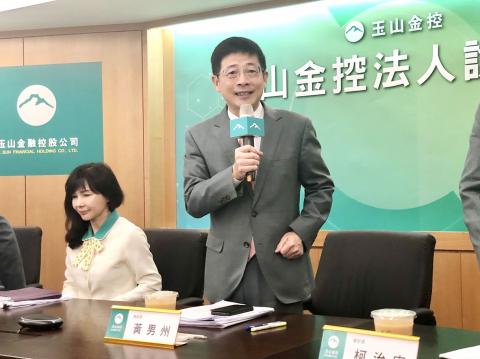E.Sun Financial Holding Co (玉山金控) yesterday posted a 10.5 percent year-on-year jump in net profit to NT$10.22 billion (US$324.58 million) for the first six months of this year on the back of growth in net fee income and lending to returning Taiwanese companies.
Earnings per share climbed to NT$0.94, compared with NT$0.91 a year earlier, company data showed.
E.Sun Bank (玉山銀行) contributed NT$10.14 billion, or 96.7 percent, of the conglomerate’s profit, while securities and venture capital units made up the remaining 3.3 percent, E.Sun Financial said.

Photo: Kelson Wang, Taipei Times
“This was the first time that E.Sun Financial and E.Sun Bank saw net profit surpass NT$10 billion for the January-to-June period,” E.Sun Financial president Joseph Huang (黃男州) told an investors’ conference in Taipei.
The company is upbeat that the momentum would continue in the second half of the year, as net profit last month rose 11 percent to NT$1.83 billion, or earnings per share of NT$1.11, Huang said.
In the first half of the year, revenue advanced 7 percent to NT$26.7 billion thanks to a 3.1 percent increase in net fee income to NT$8.66 billion, the highest for the period in the company’s history, company data showed.
Net fee income generated from the credit card business jumped 25 percent year-on-year, the data showed.
Huang attributed the increase to E.Sun Bank’s Pi mobile wallet app, which helped increase credit card spending by 19.1 percent to NT$205 billion and boost per card spending to a record-high NT$9,392 per month.
The bank’s total lending jumped 9.7 percent to NT$1.38 trillion in the first half thanks to a 14 percent surge in large corporate loans to NT$335.9 billion, company data showed.
“The bank has taken a decent share of the loan market,” Huang said.
However, he declined to reveal how much the bank had lent to local firms relocating manufacturing back to Taiwan from abroad.
Net interest income (including interest income from bond investments) gained 4.5 percent, as the bank was able to maintain its net interest margin at 1.36 percent, Huang said.
A falling Chinese yuan would have limited effects on the bank’s business, as most of its clients have chosen the US dollar for their foreign currency deposits and the US Federal Reserve late last year hiked its interest rates, E.Sun Financial chief financial officer Magi Chen (陳美滿) said.
On Monday, the yuan fell to less than 7 yuan per US dollar, but the Chinese currency is likely to rebound in the near term, as China still wants to continue negotiating with the US and solve their trade disputes, Chen said.
E.Sun Bank, which was the issuer of a credit card used to purchase a massive quantity of duty-free cigarettes during a presidential trip overseas last month that sparked a smuggling scandal, refused to comment on the transaction, citing the Money Laundering Control Act (洗錢防制法).

Among the rows of vibrators, rubber torsos and leather harnesses at a Chinese sex toys exhibition in Shanghai this weekend, the beginnings of an artificial intelligence (AI)-driven shift in the industry quietly pulsed. China manufactures about 70 percent of the world’s sex toys, most of it the “hardware” on display at the fair — whether that be technicolor tentacled dildos or hyper-realistic personalized silicone dolls. Yet smart toys have been rising in popularity for some time. Many major European and US brands already offer tech-enhanced products that can enable long-distance love, monitor well-being and even bring people one step closer to

Malaysia’s leader yesterday announced plans to build a massive semiconductor design park, aiming to boost the Southeast Asian nation’s role in the global chip industry. A prominent player in the semiconductor industry for decades, Malaysia accounts for an estimated 13 percent of global back-end manufacturing, according to German tech giant Bosch. Now it wants to go beyond production and emerge as a chip design powerhouse too, Malaysian Prime Minister Anwar Ibrahim said. “I am pleased to announce the largest IC (integrated circuit) Design Park in Southeast Asia, that will house world-class anchor tenants and collaborate with global companies such as Arm [Holdings PLC],”

Sales in the retail, and food and beverage sectors last month continued to rise, increasing 0.7 percent and 13.6 percent respectively from a year earlier, setting record highs for the month of March, the Ministry of Economic Affairs said yesterday. Sales in the wholesale sector also grew last month by 4.6 annually, mainly due to the business opportunities for emerging applications related to artificial intelligence (AI) and high-performance computing technologies, the ministry said in a report. The ministry forecast that retail, and food and beverage sales this month would retain their growth momentum as the former would benefit from Tomb Sweeping Day

Thousands of parents in Singapore are furious after a Cordlife Group Ltd (康盛人生集團), a major operator of cord blood banks in Asia, irreparably damaged their children’s samples through improper handling, with some now pursuing legal action. The ongoing case, one of the worst to hit the largely untested industry, has renewed concerns over companies marketing themselves to anxious parents with mostly unproven assurances. This has implications across the region, given Cordlife’s operations in Hong Kong, Macau, Indonesia, the Philippines and India. The parents paid for years to have their infants’ cord blood stored, with the understanding that the stem cells they contained